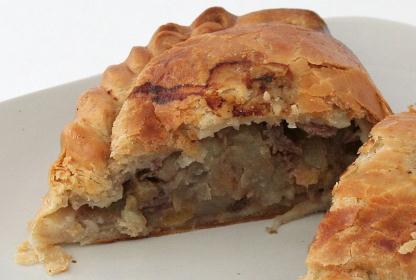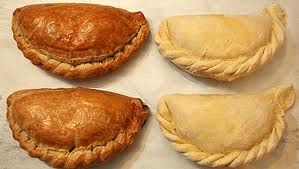

|
 Circle of shortcrust pastry, typically 8 to 16 ins diameter, 1/8 to 1/4 ins thick, heavily filled with uncooked chunks of meat and/or vegetables with pepper and salt, folded into a case, the edges crimped to give a rope twist effect seal. Baked so as to cook the filling as the pastry hardens. Cornish Pasties are never made up with minced meats, mashed potato, gravies, or any fully pre-cooked materials.  Cornish pasty, cut Image: David Johnson In 2011 The Cornish Pasty Association obtained a Protected Geographical Indicator (PGI) for the pasties, requiring that they are of "a distinctive 'D' shape and is crimped on one side, never on top. The texture of the filling for the pasty is chunky, made up of uncooked minced or roughly cut chunks of beef (not less than 12.5%), swede, potato and onion and a light peppery seasoning. The pastry casing is golden in colour, savoury, glazed with milk or egg and robust enough to retain its shape throughout the cooking and cooling process without splitting or cracking. The whole pasty is slow-baked to ensure that flavours from the raw ingredients are maximised. No flavourings or additives must be used." The PGI appears to permit pasties assembled in Cornwall to be baked elsewhere to still be designated 'Cornish'. The word 'pasty', meaning a meat pie cooked without a container, is extremely ancient. It is known at least since 1296 with a reference in the 'Warwickshire Feet of Fines' to one Simon the Pasteymaker, it occurs in 'The lay of Havelok the Dane' from 1300 and repeatedly thereafter. In 1660 (6 Jan) Samuel Pepys complains of being supplied with a venison pasty which was 'palpably beef' and the terms occurs in the plays of both Shakespeare and Ben Jonson. However, these seem to be references to the old type of all-meat pasty, like the Venison Pasty or the Beef-Joint Pasty. Indeed, the first known pasty receipt from Cornwall is precisely for such a grand meat-joint pasty, whereas what marks-out the Cornish variety as distinctive is its construction from morsels of inexpensive meat among vegetables, suited to persons of modest means.  Original Receipt from a letter from Jane Barriball, Launceston, to John Tremayne, Heligan, St Ewe, dated 9th April 1746 (Item T1363-17 part 1, Cornwall Record Office, reproduced from www.cornishpasties.org.uk) Original Receipt from a letter from Jane Barriball, Launceston, to John Tremayne, Heligan, St Ewe, dated 9th April 1746 (Item T1363-17 part 1, Cornwall Record Office, reproduced from www.cornishpasties.org.uk)Honed Sr [Honoured Sir] I have sent the receipt according to my promise wch [which] is under written from Launn 9th April 1746. Sr Yor most hble Servt, Jane Barriball [Launceston ......... Sir Your most humble Servant] A Leg or Jigget of Mutton (the Bones being taken out) is to be rubbed over with ........ Cochineal, then spiced with Mace, Cloves & Allspice, of each an equal quantity, with Salt & a little Pepper. To which put in a pint of Clarret or Port in baking. The Crust as usual The first clear description of a modern Cornish Pasty we can find is in the Leeds Times 1861, where it is plain that the author doesn't assume his readers will know what a 'Cornish Pasty' is: "The standing dish of the country, however, is the " Cornish Pasty," the normal ingredients of which, our author informs us, are " small pieces of beef, highly peppered, enclosed in a wrapper of paste, adding, however, by way of caution to hungry and unwary tourists, that they are eatable enough when quite hot, but detestable otherwise, excepting to those who like cold potato." Leeds Times - Saturday 21 December 1861 There is frequent anecdotal reference to 'two course' pasties, with meat and vegetables at one end, and fruit at the other. It is known that these have been occasionally made as novelties, but there is no historical evidence for them as everyday dishes, and they cannot be made to work well. The essential feature of the Cornish Pasty is that the filling materials are cooked together inside a well-sealed pastry so that the flavours are retained and meld. This means that a 'double-ender' inevitably ends up with unappealingly jam-flavoured meat and vegetables, and gravy-tainted fruit. Equally common is the suggestion that the thickly-rolled edge of a Cornish pasty was used as a handle by the dirty hands of tin miners who then discarded the soiled part as a meal for the 'Knockers', the capricious sprites of the mine, though it seems unlikely that hungry and poorly-paid miners would throw away such a treat.  Cooked and uncooked pasties cornishpastyassociation.co.uk Pasties have a long association with mining so that wherever Cornish miners have settled there is now a strong local pasty tradition: Nevada County in California; Butte, Montana and Anaconda in Montana and the mining regions of Pennsylvania, Wisconsin, Michigan; the cities of Pachuca and Real del Monte in the Mexican state of Hidalgo, and the Yorke Peninsula of South Australia.  Pasty Shop in Los Alamitos, California, USA Image: http://www.tripadvisor.co.uk The nickname 'Oggy' for a pasty is a corruption of the Cornish 'Hoggan'. It is said that the Devil has never dared cross the Tamar into Cornwall, for fear of Cornishwomen's habit of putting everything they find into a pasty. It said to be bad luck for fishermen to take pasties to sea. There is a long-standing argument between historians as to whether Cornwall or neighbouring Devon is the true home of the pasty. The Cornwall Record Office have a pasty receipt dated 1746, while the 1510 Receivers' Accounts for Plymouth in Devon record the purchase of pasties, but don't say where from. There is possibly a reference to pasties in the 1170's Arthurian romances by Chretien de Troyes while Shakespeare mentions pasties in 'The Merry Wives of Windsor', in 'All's Well That Ends Well', and, in 'Titus Andronicus' has Titus bake the flesh of Chiron and Demetrius into a pasty, and forces their mother to eat them. For other types of pasty, see: Beef Joint Pasty Beef Wellington Cheese and Onion Pasties Churdle Durryde Foots Fruit Turnover Ling Pie Nesebek Oggy, Oggies Peasecods Potato Table Pasty Priddy Oggie Rag Pudding Shepherd's Pie Shropshire Mint Cake Stuckling Thatched House Pie Venison Pasty Wessex Pasties Westhoughton Pasties Westmorland Currant Pasty Yorkshire Mint Pasty Polperro Pasty Not quite Cornish - Baked pastes in Pachuca, Mexico Image: Thelmadatter  |
|
MORE FROM Foods of England... Cookbooks ● Diary ● Index ● Magic Menu ● Random ● Really English? ● Timeline ● Donate ● English Service ● Food Map of England ● Lost Foods ● Accompaniments ● Biscuits ● Breads ● Cakes and Scones ● Cheeses ● Classic Meals ● Curry Dishes ● Dairy ● Drinks ● Egg Dishes ● Fish ● Fruit ● Fruits & Vegetables ● Game & Offal ● Meat & Meat Dishes ● Pastries and Pies ● Pot Meals ● Poultry ● Preserves & Jams ● Puddings & Sweets ● Sauces and Spicery ● Sausages ● Scones ● Soups ● Sweets and Toffee ● About ... ● Bookshop ● Email: [email protected] COPYRIGHT and ALL RIGHTS RESERVED: © Glyn Hughes 2022 BUILT WITH WHIMBERRY |